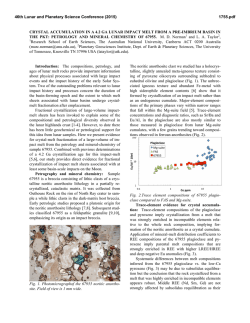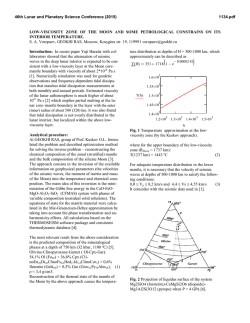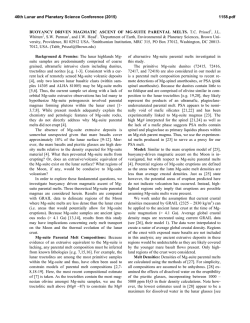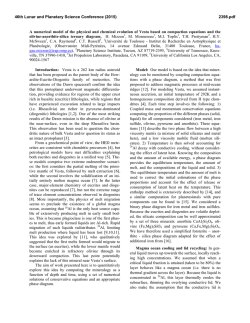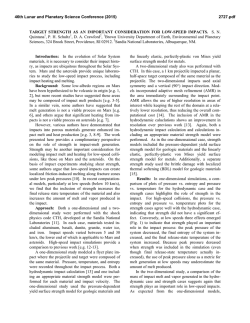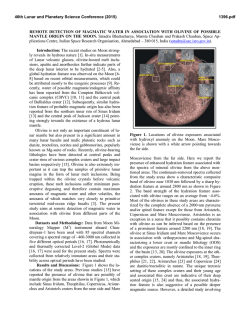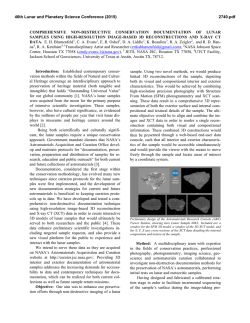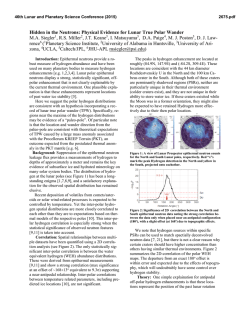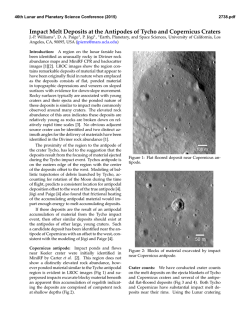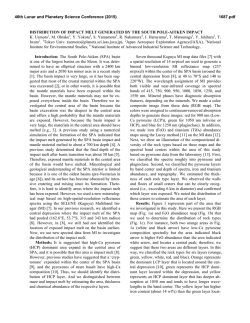
2040
46th Lunar and Planetary Science Conference (2015) 2040.pdf High fluorine and chlorine in a chromite-hosted melt inclusion from Apollo 12 olivine basalt 12035. J. A. Singer1, J. P. Greenwood1, S. Itoh2,3, N. Sakamoto2, and H. Yurimoto2, 1Dept. of Earth & Environmental Sciences, Wesleyan University, Middletown, CT 06459 USA, 2Natural History Sciences, Hokkaido University, Sapporo 0600810, Japan, 3Kyoto University, Kyoto, 606-8502, Japan. [2,11]. Natural and synthetic silicate glasses were used to calibrate measured fluorine and chlorine contents in lunar samples. Results: A chromite-ülvospinel-hosted melt inclusion from Apollo sample 12035,76a is compared to previously reported chlorine and fluorine values from more rapidly cooled basaltic glasses and melt inclusions in Fig. 1, and shown in petrographic context in Fig. 2. Two measurements of this melt inclusion yielded F contents 127 and 167 ppm, and Cl contents of 18 and 22 ppm. F and Cl values exceed previously published concentrations for lunar glasses (Fig. 1). Due to a change in analytical procedure, this melt inclusion was not measured for hydrogen content, but we measured hydrogen content of olivine-hosted melt inclusions in samples 12035,76c,e and found that they were devoid of indigenous lunar hydrogen. We measured low H content with D/H ratios indistinguishable from terrestrial sources in samples 12018,266b and 12040,216b,a2. 200 12035,76 MI 12009 matrix glass 150 F ppm Introduction: Discovery of lunar water in mare picritic glass beads [1], apatite [2-4], highland plagioclase [5], impact regolith [6], and igneous melt inclusions [7-8] indicate that much of the early Moon contained water concentrations similar to Earth’s mantle, contradicting older studies that indicated the Moon lacked indigenous water [9]. Measurements of water-rich lunar apatites suggest that most lunar magmas may be relatively dry overall [10], except for anomalous water-rich lunar picritic glass 74220 [7-8]. Primordial concentrations of the lunar volatile assemblage and the behavior and distribution of these light elements during lunar formation and differentiation remain unknown. To further understand the volatile history of the Apollo 12 olivine basalt suite, we have turned our attention towards olivine- and chromite-ülvospinelhosted melt inclusions from slowly cooled Apollo 12 rocks. The Apollo 12 olivine basalt suite likely formed from the differentiation and eruption of a single magma body, thus allowing study of the volatile assemblage as a function of cooling history [11-13]. Melt inclusions may prevent small volumes of primitive melt from interacting with the magma body during processes that alter and fractionate volatile content such as crystallization, sub-solidus diffusion, and degassing [14-17]. Because olivine grains are thought to have been the earliest crystallizing phase in the basaltic suite [18-19], olivine-hosted melt inclusions are useful for studying primitive lunar magma [13-15], while melt trapped in later forming phases such as chromite-ülvospinel and pyroxene [1819] may be useful for examining magma differentiation and degassing. We examined melt inclusions in multiple thick sections from Apollo 12 basaltic cumulates 12018, 12035, and 12040. Methods: Secondary Ion Mass Spectrometry (SIMS) analysis was conducted with the modified Cameca ims 1270 and new 1280 at Hokkaido University to measure volatile content of melt inclusions. Cameca ims 1270 measured hydrogen content and D/H ratios, and Cameca ims 1280 measured F and Cl content. Samples were mounted in low-temperature metal and polished without water to prevent hydrogen contamination. Olivine grains with melt inclusions were identified with optical microscopy and the scanning electron microscope at Wesleyan University. Ion microscopy analysis followed previous methodology for H and D 74220 MI 100 74220 matrix glass Sequeiros MORB 50 0 0 10 20 Cl ppm 30 Figure 1. F vs. Cl (ppm) for chromite-hosted melt inclusion from 12035,76, matrix glass of basalt 12009, matrix glass, olivine-hosted melt inclusions from Apollo sample 74220 [7], and Siqueiros MORB [12]. Error bars of 10% are shown for F and Cl measurements. 40 46th Lunar and Planetary Science Conference (2015) 2040.pdf that adsorbed hydrogen was present as terrestrial contamination. Summary: We measured high F in a chromitehosted melt inclusion from sample 12035,76a. Dry melt inclusions in samples 12018, 12035 and 12040 suggest H degassing or subsolidus diffusional loss during more gradual cooling. References: [1] Saal A. E. et al. (2008) Nature, 454, 192-196. [2] Greenwood J. P. et al. (2011) Nature Geosci., 4, 79-82. [3] McCubbin F. M. et al. (2010) PNAS 107, 11223. [4] Boyce J. W. et al. (2010) Nature 466, 466. [5] Hui H. et al. (2013) Nature Geosci., doi:10.1038/NGEO1735. [6] Liu Y. et al. (2012) Nature Geosci. doi:10.1038/NGEO1601. [7] Hauri E. et al. (2011) Science, doi: Figure 2. Calcium WDS map of the chromitehosted melt inclusion (top-center), chromite host, and petrographic context. Pyroxene encloses the chromite-host. Discussion: Elevated F/Cl content of chromitehosted lunar melt inclusion. F and Cl concentrations in the chromite-hosted melt inclusion of 12035,76 exceed previously reported values of lunar melt inclusions, glasses, and Siqueiros MORB primitive terrestrial melt inclusions [8] (Fig. 2). Chromite is predicted to have crystallized after olivine at pressures of 1 atm [18-19], so these high F and Cl concentrations may be results of differentiation and degassing of the melt that occurred during olivine crystallization and before entrapment of this inclusion [15-16]. The chromiteülvospinel grain appears to have been enclosed by a pyroxene grain after its crystallization (Fig. 2). Upon eruption, these surrounding minerals would have prevented degassing or diffusion of F and Cl, such that they remained present in this inclusion at elevated concentrations. Hydrogen content, 12035,76c,e Unlike previously reported lunar melt inclusions with high F and Cl, melt inclusions from sample 12035,76 held no apparent water. This may be due to magmatic degassing before entrapment of melts [17] or sub-solidus diffusion of hydrogen out of melt inclusions [15]. Hydrogen degassing is faster and more efficient than F or Cl degassing [15]. In the lowgravity, low-pressure lunar environment, this could explain why F and Cl remained trapped in the absence of water [15-16]. The expected slow cooling of this cumulate textured gabbroic rock would likely have allowed sufficient time for diffusional loss of hydrogen from this melt inclusion. Hydrogen content, 12018,266b and 12040,216b,a2 In samples 12018,266b and 12040,216b,a2, D/H measurements in melt inclusions resemble terrestrial values, either indicating that we measured lunar hydrogen with similar origins to Earth’s mantle [8], or 10.1126/science.1204626. [8] Saal et al. (2013) Science, doi: DOI: 10.1126/science.1235142. [9] Epstein S. and Taylor H. P. (1973) GCA, 2, 1559-1575. [10] Boyce (2014) Nature DOI: 10.1126/science.125039. [11] Greenwood et al. (2014) LPSC p.2707. [12] Kushiro I. and Haramura H. (1971) Science, 171, 12351237. [13] Walker et al. (1976) Proc. Lunar Sci. Conf. 7th, 1365-138. [14] Kent A. J. R. (2008) Reviews in Mineralogy & Geochemistry, Vol. 69, 273-331. [15] Métric N. and Wallace P. J. (2008) Reviews in Mineralogy & Geochemistry, Vol. 69 p. 363-402. [16] Edmonds M. and Terrence M. G. (2009) Chemical Geology 263.1 (2009): 122-130. [17] Saal A. E. and Hauri E. H. (2002) Nature, doi:10.1038/nature01073. [18] Green et al. (1971) LPSC Proceedings Vol. 2, doi: 1971LPSC....2..601G. [19] Champness (1971) LPSC Proceedings, Vol. 2 doi: LPSC….2.359C.
© Copyright 2025
